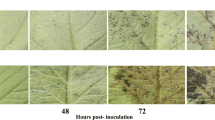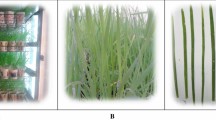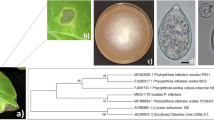Abstract
The relationship between active oxygen metabolism and resistance to late blight (Phytophthora infestans) in potato (Solanum tuberosum L.) was studied for 72 h post-inoculation by comparing three resistant cultivars (low disease index) with three susceptible ones (high disease index). Activities of superoxide dismutase (SOD), catalase (CAT) and ascorbate peroxidase (APX), and the content of ascorbic acid (ASA), were higher in the resistant cultivars than in the susceptible ones. The production rate of the superoxide anion radical (O2−) was lower in the resistant cultivars than in the susceptible ones. These changes, which were associated with the potato plant’s response to infection with P. infestans, provide some insight into the physiological basis of resistance and may also provide a screening tool for resistance to late blight.
Similar content being viewed by others
Avoid common mistakes on your manuscript.
Introduction
The potato (Solanum tuberosum L.) plays an important role in food production in Inner Mongolia, North China (Vleeshouwers et al. 2011, Haverkort et al. 2009). Rainfall, temperature and soil conditions are conducive to potato production, so this region has one of the largest growing areas and highest potato yields in China, which is the largest potato producer in the world.
Potato production is affected by many different diseases, especially late blight. Late blight is caused by the oomycete Phytophthora infestans (Mont.) de Bary and is potentially the most devastating disease of potato worldwide (Fry and Goodwin 1997). Symptoms of late blight include chlorosis, necrosis, vascular discoloration, stunting and wilting (Jean 1998; Park et al. 2005; Fry 2008), resulting in reductions in both tuber quality and yield. Annual worldwide potato crop losses due to late blight have been conservatively estimated at 6.7 billion dollars (Haverkort et al. 2008).
Late blight in potato can also be viewed as an example of biotic stress. Many biotic stresses induce the formation of reactive oxygen species (ROS) in plant cells and lead to the oxidative destruction of cells (Schützendübel and Polle 2002). To protect cellular compartments from the damaging effects of ROS, plants have evolved multiple detoxification mechanisms, including synthesis of antioxidant molecules (ascorbic acid, glutathione and carotenoids) and enzyme systems such as superoxide dismutase (SOD), ascorbate peroxidase (APX) and catalase (CAT). As part of a plant’s defence mechanisms, several studies have documented that plants can regulate the enzyme systems’ activity to enhance disease resistance under biotic stresses (Wojtaszek 1997; Bolwell et al. 2002; Bhattacharjee 2005; Torres et al. 2006).
It is expected that oxidative stress is likely to be an important component of potato response to late blight. The objective of this work was to compare the changes in active oxygen metabolism in resistant and susceptible potatoes before and after inoculation with Phytophthora infestans, to ascertain whether late blight induces oxidative stress, and whether it is involved in disease tolerance mechanisms. Knowledge of the relationship between active oxygen metabolism and disease tolerance will improve our understanding of the physiology of disease resistance and may facilitate potato breeding for late blight resistance.
Materials and Methods
Plants and Inoculation Procedure
Six potato cultivars were used in this study: Neishu No. 7, Tiger Head and Kexin No. 1, which are known to be resistant to P. infestans, and Atlanta, Favorita and Shepody, which are known to be susceptible. Tubers were planted in plastic pots in a mixture of sand and soil (1:1, v/v) supplemented with slow-release fertiliser in a greenhouse (20/15 ± 2 °C day/night temperatures, 16-h photoperiod, light intensity of 300 μmol m−2 s−2) until tuber initiation.
P. infestans race 3a.3b.4.7.10, mating type A1, was provided by Inner Mongolia Academy of Agricultural and Animal Husbandry Sciences, Huhhot. This virulent strain was isolated from an infected potato plant in 2002 in Huhhot and propagated in vitro until its use as inoculum in our experiment. P. infestans was grown on rye medium and maintained in darkness at 18 °C for mycelia and sporangia production. After 10 days, mycelia were harvested in sterile water and stimulated to release zoospores by incubation for 4 h at 4 °C. After filtration through muslin, the resulting suspension was observed with a light microscope to quantify spores and sporangia. The concentration was adjusted to 105 sporangia ml−1.
All plants were inoculated with P. infestans at tuber initiation by spraying a zoospore suspension evenly on the plant foliage with a hand sprayer. Plants were left for 15 h at 20 °C and 90% relative humidity to allow disease progression. Finally, control leaves were sprayed with water instead of suspension. Then six intermediary fully expanded leaves for each cultivar (two leaves × three plants) were sampled 0, 24, 48 and 72 h after inoculation and frozen in liquid nitrogen. The experiment was repeated independently three times.
Enzyme Assay
Superoxide anion radical (O2−) content was determined according to protocol of Doke (1983). SOD activity was assayed using the method described by Beauchamp and Fridovich (1971). CAT activity was analysed using the method of Dhindsa et al. (1981) and Aebi (1984), as described by Morkunas and Bednarski (2008). APX and ASA activity were measured spectrophotometrically at 290 and 265 nm using the methods of Nakano and Asada (1981) and Luwe et al. (1993) with minor modifications.
Disease Index
The disease index was calculated according to the formula:
The disease grades were as follows: grade 0, lesion area was under 5%; grade 3, lesion area was 6–10%; grade 5, lesion area was 11–20%; grade 7, lesion area was 21–50%; grade 9, lesion area was > 50%.
Statistical Analysis
Statistical analyses were carried out by analysis of variance (ANOVA) and the means were compared by t tests at the 5% level of significance. SAS software (SAS Institute, Inc. Version 8.0) was used for the analysis of variance. GraphPad Prism software (version 6.0) was used for the figures.
Results
Disease Index After Inoculation
The disease indices of the six cultivars after inoculation confirmed their classification as susceptible or resistant and revealed the rate of infection (Table 1). Furthermore, there were differences between the three susceptible cultivars (Shepody > Atlantic > Favorita) and between the three resistant ones (Kexin > TigerHead > Neishu).
Effect of P. infestans Infection on Active Oxygen Metabolism
The O2− concentrations remained constant without inoculation (Fig. 1a). However, all cultivars exhibited an increase in O2− production 24 h after inoculation (Fig. 1b). Subsequently, between 24 and 72 h post-inoculation, O2− concentrations in the three susceptible cultivars were higher than those of the three resistant cultivars. Higher O2− concentrations within the three susceptible cultivars were most evident 24 and 48 h after inoculation.
SOD activity slightly increased in all six potato cultivars in uninoculated plants from 0 to 72 h, but there were no significant differences between resistant and susceptible cultivars (Fig. 2a). However, SOD activity was enhanced in all six potato cultivars after inoculation with P. infestans (Fig. 2b). In the resistant cultivars, SOD activity increased quickly in the first 24 h after inoculation compared to the three susceptible cultivars. For resistant cultivars, SOD activity reached its highest values 24 h post-inoculation and then gradually decreased. For susceptible cultivars, SOD activity increased more slowly and reached maximum levels after 48 h. From 48 to 72 h post-inoculation, SOD activities were not significantly different between resistant and susceptible cultivars.
CAT activity remained stable without inoculation (Fig. 3a). Inoculation caused an increase in the levels of CAT activity in the six potato cultivars (Fig. 3b). However, the CAT activity of the three resistant cultivars increased to significantly higher rates compared to the three susceptible cultivars 24 to 48 h after inoculation. The highest values of CAT activity for resistant cultivars occurred 48 h post-inoculation, followed by a decrease in CAT activity from 48 to 72 h post-inoculation. Despite this decline, CAT activity of the resistant cultivars was greater than that of the susceptible cultivars at 72 h post-inoculation.
ASA concentration remained stable without inoculation (Fig. 4a). ASA concentration was higher in resistant cultivars than in the susceptible cultivars 24 and 48 h after inoculation (Fig. 4b). However, the increase in ASA concentration for resistant cultivars was only statistically significant at 48 h post-inoculation. The greatest elevation in ASA concentration in resistant cultivars occurred 48 h after inoculation, and by 72 h ASA concentration declined to a level similar to that found in the susceptible cultivars.
APX activity remained stable without inoculation (Fig. 5a). APX activity increased in all cultivars after inoculation with P. infestans, although the extent differed between the resistant and susceptible cultivars (Fig. 5b). APX activity increased within 24 h in the susceptible cultivars. In the resistant cultivars, APX did not increase before 24 h post-inoculation, although the activity was greater in resistant cultivars relative to the susceptible ones 48 h after inoculation.
Discussion
A rapid increase in the concentrations of reactive oxygen species (ROS) is known to be an early plant response to pathogen infection (Wojtaszek 1997), and some evidence has shown that this burst of ROS species is involved in plant defence responses. For example, increased accumulations of ROSs were detected in wheat attacked by Diuraphis noxia (Biemelt et al. 1998; Xinzhi et al. 2001; Moloi and van der Westhuizen 2006), in peach resistant to Myzus persicae (Sauge et al. 2002), in barley and oat in response to feeding of Schizaphis graminum and Rhopalosiphum padi (Smith and Boyko 2007) and in pea in response to Acyrthosiphon pisum (Mai et al. 2013). Among the ROS, O2− is thought to play an important role in plant defence mechanisms. O2− generation in response to biotic stress has been found in a wide range of plant species during plant-pathogen interactions involving avirulent bacteria, fungi and viruses (Doke and Ohashi 1988; Apel and Hirt 2004; Morkunas et al. 2008). In addition, O2− can be converted into H2O2 and oxygen in an important step for protecting the cell against oxidative damage, and in that conversion, SOD is considered to be a key enzyme (Abassi et al. 1998; Orozco-Cardenas and Ryan 1999). CAT and peroxidases such as APX are important antioxidant enzymes in scavenging or utilising H2O2. As key elements in plant defence, changes in ROS-scavenging enzyme activities have been found in response to a wide range of environmental stresses. For example, it has been reported that ROS-scavenging enzymes increased under iron deficiency in maize (Sun et al. 2007), under heat stress in the callus of reed (Song et al. 2006) and under drought stress in rice (Shehab et al. 2010).
In the present experiment, we found changes in the rate of O2− production, the activities of SOD, CAT and APX and ASA concentration in leaves of six cultivars of potatoes after inoculation with P. infestans, the causal organism of late blight. Significant differences in the rate of O2− production, the activities of SOD, CAT and APX, and ASA concentration were noted between resistant and susceptible cultivars. Although both susceptible and resistant cultivars contained antioxidative enzymes and the antioxidative metabolite, ASA, antioxidative enzymes and ASA concentrations were generally greater in the resistant cultivars, and the rate of O2− production was lower in the resistant cultivars. These differences were clearest from 24 to 48 h post-inoculation whereas the differences in severity of the disease (disease index) were clearest from 48 to 72 h post-inoculation. These results suggest that the former may be the cause of the latter and hence provide some insight into the physiological basis of resistance. They indicate that the oxidative enzymes differ in the rate at which they are induced by pathogen infection and suggest that the enzymes contribute to the antioxidative defence of the plant at different times post-infection. These results imply that active oxygen metabolism may play an important role in protecting potatoes from the oxidative damage generated during pathogen attack. They may also be useful in future breeding efforts for resistance to late blight since they provide a physiological basis for late blight resistance that can be used for screening germplasm.
Abbreviations
- ROS:
-
Reactive oxygen species
- O2 − :
-
Superoxide anion radical
- SOD:
-
Superoxide dismutase
- CAT:
-
Catalase
- ASA:
-
Ascorbic acid
- APX:
-
Ascorbate peroxidase
References
Abassi NA, Kushad MM, Endress AG (1998) Active oxygen-scavenging enzymes activities in developing apple flowers and fruits. Sci Hortic 74(3):183–194. https://doi.org/10.1016/S0304-4238(98)00077-6
Aebi H (1984) Catalase in vitro. Methods Enzymol 105(C):121–126. https://doi.org/10.1016/S0076-6879(84)05016-3
Apel K, Hirt H (2004) Reactive oxygen species: metabolism, oxidative stress, and signal transduction. Annu Rev Plant Biol 55(x):373–399. https://doi.org/10.1146/annurev.arplant.55.031903.141701
Beauchamp C, Fridovich I (1971) Superoxide dismutase: improved assays and assay applicable to acrylamide gels. Anal Biochem 44(1):276–287. https://doi.org/10.1016/0003-2697(71)90370-8
Bhattacharjee S (2005) Reactive oxygen species and oxidative burst: roles in stress, senescence and signal transduction in plants. Curr Sci 89(7):1113–1121. https://doi.org/10.1080/15216540252774694
Biemelt S, Keetman U, Albrecht G (1998) Re-aeration following hypoxia or anoxia leads to activation of the antioxidative defense system in roots of wheat seedlings. Plant Physiol 116(2):651–658. https://doi.org/10.1104/pp.116.2.651
Bolwell GP, Bindschedler LV, Blee KA, Butt VS, Davies DR, Gardner SL, Gerrish C, Minibayeva F (2002) The apoplastic oxidative burst in response to biotic stress in plants: a tree component system. J Exp Bot 53(372):1367–1376. https://doi.org/10.1093/jxb/53.372.1367
Dhindsa RS, Plumb-Dhindsa P, Thorpe TA (1981) Leaf senescence: correlated with increased levels of membrane permeability and lipid peroxidation, and decrease levels of superoxide dismutase and catalase. J Exp Bot 32(126):93–101. https://doi.org/10.1093/jxb/32.1.93
Doke N (1983) Involvement of superoxide anion generation in the hypersensitive response of potato tuber tissues to infection with an incompatible race of Phytophthora infestans and to the hyphal wall components. Physiol Mol Plant Pathol 23(3):345–355. https://doi.org/10.1016/0048-4059(83)90019-X
Doke N, Ohashi Y (1988) Involvement of O2 − generating system in the induction of necrotic lesions on tobacco leaves infected with tobacco mosaic virus. Physiol Mol Plant Pathol 32(1):163–175. https://doi.org/10.1016/S0885-5765(88)8001
Fry W (2008) Phytophthora infestans: the plant (and R gene) destroyer. Mol Plant Pathol 9(3):385–402. https://doi.org/10.1111/j.1364-3703.2007.00465.x
Fry WE, Goodwin SB (1997) Re-emergence of potato and tomato late blight in the United States. Plant Dis 81(12):1349–1357. https://doi.org/10.1094/PDIS.1997.81.12.1349
Haverkort AJ, Boonekamp PM, Hutten R, Jacobsen E, Lotz LAP, Kessel GJT, Visser RGF, Van Der Vossen EAG (2008) Societal costs of late blight in potato and prospects of durable resistance through cisgenic modification. Potato Res 51(1):47–57. https://doi.org/10.1007/s11540-008-9089-y
Haverkort A, Struik PC, Visser R, Jacobsen E (2009) Applied biotechnology to combat late blight in potato caused by Phytophthora infestans. Potato Res 52(3):249–264. https://doi.org/10.1007/s11540-009-9136-3
Jean BR (1998) The importance of archival and herbarium materials in understanding the role of oospores in late blight epidemics of the past. Phytopathology 88(11):1120–1130. https://doi.org/10.1094/PHYTO.1998.88.11
Luwe MWF, Takahama U, Heber U (1993) Role of ascorbate in detoxifying ozone in the apoplast of spinach (Spinacia oleracea L.) leaves. Plant Physiol 101(3):969–976. https://doi.org/10.1104/pp.101.3.969
Mai VC, Waldemar B, Borowiak-Sobkowiak B, Wilkaniec B, Samardakiewicz S, Morkunas I (2013) Oxidative stress in pea seedling leaves in response to Acyrthosiphon pisum infestation. Phytochemistry 93(1):49–62. https://doi.org/10.1016/j.phytochem.2013.02.011
Moloi MJ, van der Westhuizen AJ (2006) The reactive oxygen species are involved in resistance responses of wheat to the Russian wheat aphid. J Plant Physiol 163(11):1118–1125. https://doi.org/10.1016/j.jplph.2005.07.014
Morkunas I, Bednarski W (2008) Fusarium oxysporum-induced oxidative stress and antioxidative defenses of yellow lupine embryo axes with different sugar levels. J Plant Physiol 165(3):262–277. https://doi.org/10.1016/j.jplph.2007.01.020
Morkunas I, Bednarski W, Kopyra M (2008) Defense strategies of pea embryo axes with different levels of sucrose to Fusarium oxysporum and Ascochyta pisi. Physiol Mol Plant Pathol 72(4):167–178. https://doi.org/10.1016/j.pmpp.2008.09.003
Nakano Y, Asada K (1981) Hydrogen peroxide is scavenged by ascorbate specific peroxidase in spinach chloroplasts. Plant Cell Physiol 22(5):867–880. https://doi.org/10.1093/oxfordjournals.pcp.a076232
Orozco-Cardenas M, Ryan CA (1999) Hydrogen peroxide is generated systemically in plant leaves by wounding and systemin via the octadecanoid pathway. Proc Natl Acad Sci U S A 96(11):6553–6557. https://doi.org/10.1073/pnas.96.11.6553
Park TH, Vleeshouwers VGAA, Kim JB, Hutten RCB, Visser RGF (2005) Dissection of foliage and tuber late blight resistance in mapping populations of potato. Euphytica 143(1):75–83. https://doi.org/10.1007/s10681-005-2658-0
Sauge MH, Lacroze JP, Poessel JL, Pascal T, Kervella J (2002) Induced resistance by Myzus persicae in the peach cultivar ‘Rubira’. Entomol Exp Appl 102(1):29–37. https://doi.org/10.1023/A:1015282702657
Schützendübel A, Polle A (2002) Plant responses to abiotic stresses: heavy metal-induced oxidative stress and protection by mycorrhization. J Exp Bot 53(372):1351–1365. https://doi.org/10.1093/jexbot/53.372.1351
Shehab GG, Ahmed OK, El-Beltagi HS (2010) Effects of various chemical agents for alleviation of drought stress in rice plants (Oryza sativa L.). Not Bot Hort Agrobot Cluj 38(1):139–148. https://doi.org/10.15835/nbha3813627
Smith CM, Boyko EV (2007) The molecular bases of plant resistance and defense responses to aphid feeding: current status. Entomol Exp Appl 122(1):1–16. https://doi.org/10.1111/j.1570-7458.2006.00503.x
Song L, Ding W, Zhao M, Sun B, Zhang L (2006) Nitric oxide protects against oxidative stress under heat stress in the calluses from two ecotypes of reed. Plant Sci 171(4):449–458. https://doi.org/10.1016/j.plantsci.2006.05.002
Sun B, Jing Y, Chen K, Song L, Chen F, Zhang L (2007) Protective effect of nitric oxide on iron deficiency-induced oxidative stress in maize (Zea mays). J Plant Physiol 164(5):536–543. https://doi.org/10.1016/j.jplph.2006.02.011
Torres MA, Jones JD, Dangl JL (2006) Reactive oxygen species signalling in response to pathogens. Plant Physiol 141(2):373–378. https://doi.org/10.1104/pp.106.079467
Vleeshouwers VGAA, Raffaele S, Vossen JH, Champouret N, Oliva R, Segretin ME, Rietman H, Cano ML, Lokossou A, Kessel G, Pel MA, Kamoun S (2011) Understanding and exploiting late blight resistance in the age of effectors. Annu Rev Phytopathol 49(1):507–531. https://doi.org/10.1146/annurev-phyto-072910-095326
Wojtaszek P (1997) Mechanisms for the generation of reactive oxygen species in plant defence response. Acta Physiol Plant 19(4):581–589. https://doi.org/10.1007/s11738-997-0057-y
Xinzhi N, Sharron SQ, Tiffany H, John M, Gautam S, Robert K, Frederick B (2001) Oxidative responses of resistant and susceptible cereal leaves to symptomatic and nonsymptomatic cereal aphid (Hemiptera: Aphididae) feeding. J Econ Entomol 94(3):743–751. https://doi.org/10.1603/0022-0493-94.3.743
Funding
This project was financially supported by Doctoral Research foundation of Inner Mongolia Agriculture University (BJ201312-5).
Author information
Authors and Affiliations
Corresponding author
Rights and permissions
About this article
Cite this article
Li, G., Zhang, X. & Zhang, S. The Relationship Between Active Oxygen Metabolism and Resistance to Late Blight in Potato. Potato Res. 61, 365–373 (2018). https://doi.org/10.1007/s11540-018-9391-2
Received:
Accepted:
Published:
Issue Date:
DOI: https://doi.org/10.1007/s11540-018-9391-2









